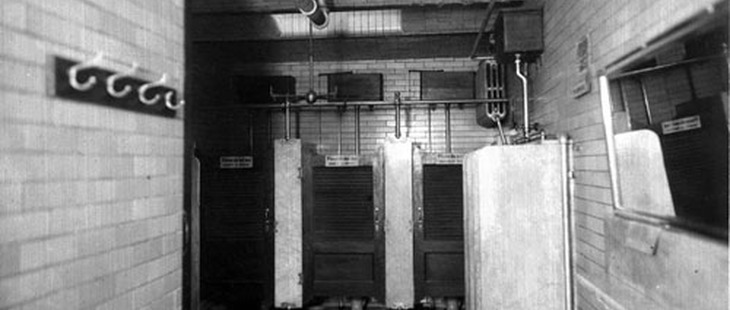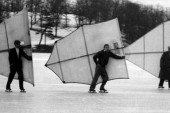
(City of Toronto Archives) Say what you will about the police in early 1900s, they came straight to the point: “In a lane off 230 Yonge Street [the] defendant came in and took his penis and after he got it stiff Frank H. came in and held the penis and pulled it back and forwards.” Or consider this report from the 1913 CNE: “at the rear of the firehall… [I] saw James C. having Charles W.’s person in his mouth.” Or this account from Queen’s Park: while patrolling “[I] heard a sound like sucking… [and observed a man] lying on his back and another man… kneeling with his mouth towards his privates.” When the city’s elite citizens first began to invoke the idea of “Toronto the Good” it was not as description, but as prescription; not analysis, but reaction. “Toronto the Good” was a rallying cry, a call to build a conservative and moral city on a hill. And no wonder, looking around them they saw an emergent metropolis entirely at odds with their vision: Toronto was sometimes ribald, sometimes atheist, and often gay. Which is why police officers began to find themselves on a new beat at the turn of the century. As darkness fell working-class homosexual men would seek out places for sex, for conversation, for flirting. Unlike New York or Chicago, single men in Toronto rarely had access to private space. Featuring few tenements, most dwellings in Toronto were single-family houses or small apartment buildings. There simply were no cheap places available for rent and the working poor were forced to live with their families or in public boarding houses. Unsanctioned sex was, thus, compelled to move onto the street or into the park. Gay men hoped that a bush or a cranny would provide privacy and shelter from the gaze of the policeman or a moral reformer (who, yes, wandered the streets). Given that it was an era before public street lamps, Allen Gardens, Queen’s Park and High Park became meeting areas for the city’s gay men. The trees, the darkness, the bushes all provided a modicum of protection from prying eyes. It was here that Toronto’s first gay sub-culture began to develop: people knew where to meet, developed an etiquette for pick ups and fomented a community that would persist and flourish over the next hundred years. Located near the city’s main working class areas, the Ward and Cabbagetown, these parks were the safest semi-private places to meet for an assignation. (City of Toronto Archives) But more important than the parks were Toronto’s public lavatories. In the first part of the twentieth century few poor neighborhoods were connected to the city’s sewage system. Worried about disease festering in open privies (an important concern in the “cleanliness equals godliness” era), the city undertook a massive public works program to build public washrooms. Found in every poor neighbourhood and every public space, these provided privacy and became the preferred places for gay men to meet. Holes, glory holes, were cut between stalls to allow for sexual contact, doors could be locked and men could enter the building together without necessarily arousing suspicion. “Toronto the Good,” however, struck back. Proving that the state has an interest, not only in the country’s bedrooms, but its washrooms, police introduced a series of technical innovations to monitor sex in the city’s lavatories. At their most voyeuristic (and creepy) the police constructed lavatories with, you can’t make this up, peepholes accessible by ladder where officers would stand themselves for hours watching as, umm, people attended to their business. Occasionally two lovers would walk in and, after being watched for a minute or two, be arrested by the police. As officers reported about the lavatory at Allen Gardens: “There is a hole in the wall at the back… [and] you can look down into all the compartments… we have a platform built at the back using ladders.” Also, ever wonder why doors on bathroom stalls are a foot or so off the ground? All of this could be amusing except that the consequences for the men caught were incredibly dire. A charge of Gross Indecency or Buggery almost guaranteed years in prison, of hard labour, or restricted diets; not to mention the negative psychological impacts of being outed publicly by the justice system in a city not known for its tolerance. To be sure there were exceptional moments, where people closed ranks around an accused, but more often than not the only recourse for a man caught having sex with another man was, simply, to run as fast as he could. And, for what it’s worth, it’s important to remember that the geography that forced gay men into the parks, crannies and lavatories forced lovers of all sorts into the same places. Public space was, ironically, the only place many Torontonians could find for a private moment. Lost in a bush, discovering or rediscovering sexuality, Toronto’s poor lovers knew too much of the two cities: the liberatory one hidden in the crannies, and the regimented totalizing one of searching streetlights, of hidden platforms and monitored washrooms and of hideously unjustifiable incarceration. Note: Quotations from Steven Maynard’s article “Through a Hole in the Lavatory Wall” published in the Journal of Human Sexuality, 5:2, 1994. __ Simon Wallace writes the Standard Historical Society column for Toronto Standard.














